新目标英语七年级下册1—6单元重要语法知识
七下英语一至六单元知识点

七下英语一至六单元知识点七下英语一至六单元知识点如下:一、第一单元:1. 重要词汇:title, article, paragraph, sentence, clause, subject, verb, object。
2. 重要语法:复合句 (complex sentence),包括主语从句、宾语从句、表语从句和同位语从句。
3. 重要句型:a. It"s + adj. + to do sth. / It"s + noun + to do sth. / It"s +adj. + that + noun + do sth. / It"s + noun + that + noun + do sth.。
b. It"s + adj. + to be + noun.c. It"s + noun + to be + adj..4. 拓展:宾语从句常用连词有:that, if, why, whether, who, whose, what 等。
5. 重要练习:完成句子 (fill in the blanks) 和阅读理解(reading comprehension)。
二、第二单元:1. 重要词汇:idiom, idioms, colloquialism, slang, colloquial。
2. 重要语法:名词的单复数形式 (single and double plural),如:fish(鱼)- fish(鱼),book(书)- books(书)。
3. 重要句型:a. As + adj. + as + 主语 + 谓语。
b. Not as + adj. + as + 主语 + 谓语。
c. The more + adj. + the + adj. + 主语 + 谓语。
d. The + adj. + of + 名词 + 主语 + 谓语。
4. 拓展:名词的单复数形式常用变法有:加-s, -es, 去-s, 加-s 或-es,如:fish(鱼)- fish(鱼), woman(女人)- women(女人), house(房子)- houses(房子)。
七年级下册英语(M1-M6)各单元重要短语、句型汇总

七年级下册英语(M1-M6)各单元重要短语、句型汇总Module1 Lost and Found【重点短语】1. lost and found box 失物招领箱2. welcome back 欢迎回来3. first of all 首先4. here is/are... 这有...5. from now on 从现在开始6. be careful with 小心保管7. whose bag 谁的包8. talk to sb. 与某人交谈9. mobile phone 移动电话,手机10. get on 上车( get off 下车)11. two thousand 两千(thousands of 数以千计的...)12. look for 寻找13. at the moment 现在14. in a hurry 匆忙地15. alot of 许多,大量16. hundreds of 数以百计的17. on the train 在火车上18. every day 每天19. such as 例如20. make a list of 列一张...的清单21. ask/answer questions 问/回答问题【重点句型】1. Welcome back to school! 欢迎回到学校!2. Whose bag is this? 这是谁的书包?3. It’s mine. 它是我的。
4. Are these crayons yours? 这些是你的蜡笔吗?5. Whose tapes are these? 这些是谁的磁带?6. Here’s a purple wallet! 这儿有个紫色钱包。
7. I think i t’s Betty’s. 我认为它是贝蒂的。
8. Everyone, please be careful with your things from now on. 请大家从今以后仔细对待你们的东西。
七年级下册英语第六单元知识点
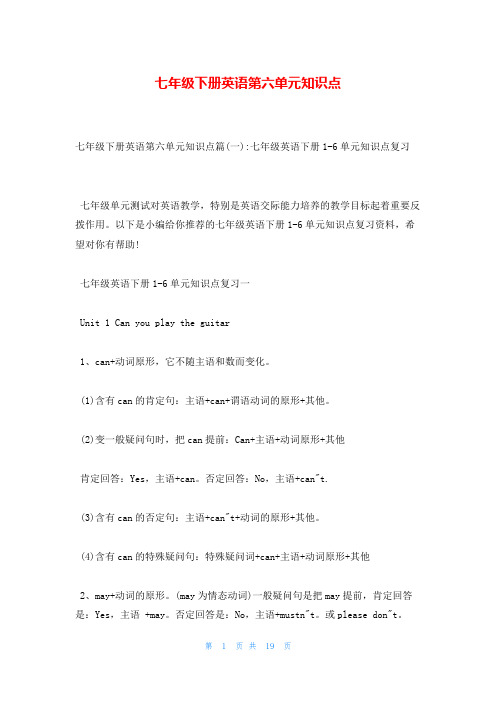
七年级下册英语第六单元知识点七年级下册英语第六单元知识点篇(一):七年级英语下册1-6单元知识点复习七年级单元测试对英语教学,特别是英语交际能力培养的教学目标起着重要反拨作用。
以下是小编给你推荐的七年级英语下册1-6单元知识点复习资料,希望对你有帮助!七年级英语下册1-6单元知识点复习一Unit 1 Can you play the guitar1、can+动词原形,它不随主语和数而变化。
(1)含有can的肯定句:主语+can+谓语动词的原形+其他。
(2)变一般疑问句时,把can提前:Can+主语+动词原形+其他肯定回答:Yes,主语+can。
否定回答:No,主语+can"t.(3)含有can的否定句:主语+can"t+动词的原形+其他。
(4)含有can的特殊疑问句:特殊疑问词+can+主语+动词原形+其他2、may+动词的原形。
(may为情态动词)一般疑问句是把may提前,肯定回答是:Yes,主语 +may。
否定回答是:No,主语+mustn"t。
或please don"t。
join+某个组织,俱乐部,party,参军,党派等“加入”Join sb. “参加到某人中” join in (doing)sth “加入做......,参加某个活动” Join in=take part in +活动,比赛3、说某种语言:speak+语言4、play+球、棋、牌;play+the+乐器。
5、擅长于(做)什么:be good at +名词/动ing6、帮助某人做某事:help sb. (to ) do sth. help sb. with sth.7、我能知道你名字吗May I know your name8、想要做什么:want to do sth 例如:I want to learn about art.9、What club do you want to joinI want to join the chess club and the basketball club.10、What club does Tom want to join He wants to join the swimming club .11、He can’t play the violin or the piano. Can you help kids with swimming12、Why do you want to join the English club Because I want to learn English well.Unit 2 What time do you go to school1、what time和when引导的特殊疑问句。
人教新目标英语七年级下册unit 1 课堂思维导图笔记
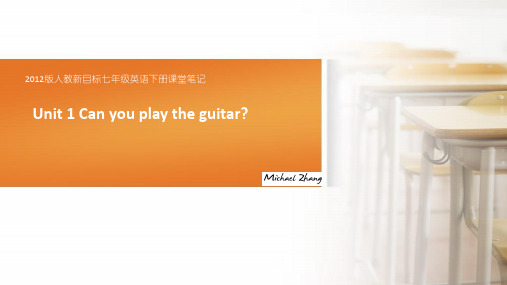
Section B 考点解析
2. Are you free in July?
你七月份有空吗?
Section B 考点解析
3. Are you good with old people?
你善于与老年人相处吗?
Section B 考点解析
4. They can tell you stoies, and you can make friends.
speaker
说话者,演讲者
speak English
说英语
First think, and then speak.
三思而后行
Section A 重点词汇
8. join 参加,加入
Come and join us, Mike.
join sb.
加入某人
join 动词
连接,联合
Section A 重点词汇
1. play chess
下国际象棋
play tห้องสมุดไป่ตู้e guitar
弹吉他
Section A考点解析
2. I want to join the art club.
我想参加美术社团。
Section A考点解析
3. Can you draw?
你会画画吗?
Can you sing English song?
请放学后和张老师谈。
Don’t sit on the chair. It is wet.
Section A考点解析
1. I can speak English and I can also play soccer.
我会说英语,我也会踢足球。
I also like math. He is also a student.
新目标(Go for it)版七年级英语下册各单元知识点总结
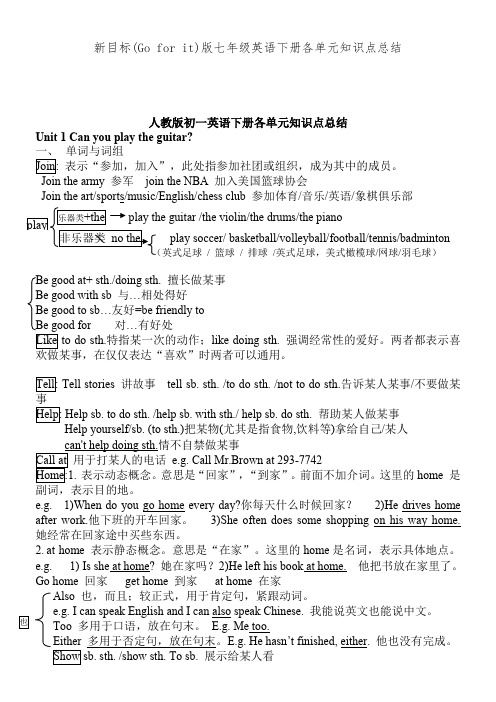
新目标(Go for it)版七年级英语下册各单元知识点总结人教版初一英语下册各单元知识点总结Unit 1 Can you play the guitar?一、 单词与词组表示“参加,加入”,此处指参加社团或组织,成为其中的成员。
Join the army 参军 join the NBA 加入美国篮球协会Join the art/sports/music/English/chess club 参加体育/音乐/英语/象棋俱乐部play soccer/ basketball/volleyball/football/tennis/badminton / 篮球 / 排球 /英式足球,美式橄榄球/网球/羽毛球)Be good at+ sth./doing sth. 擅长做某事Be good with sb 与…相处得好Be good to sb …友好=be friendly toBe good for 对…有好处特指某一次的动作;like doing sth. 强调经常性的爱好。
两者都表示喜讲故事 tell sb. sth. /to do sth. /not to do sth.告诉某人某事/不要做某帮助某人做某事Help yourself/sb. (to sth.)把某物(尤其是指食物,饮料等)拿给自己/某人e.g. Call Mr.Brown at 293-7742意思是“回家”,“到家”。
前面不加介词。
这里的home 是e.g. 1)When do you go home every day?你每天什么时候回家? 2)He drives home after work.他下班的开车回家。
3)She often does some shopping on his way home. 她经常在回家途中买些东西。
2. at home 表示静态概念。
意思是“在家”。
这里的home 是名词,表示具体地点。
七年级下册英语1到6单元知识点手抄报

七年级下册英语1到6单元知识点手抄报一、单元一:Unit 1 What’s the matter?1. 词汇及短语illness 疾病headache 头痛stomachache 胃疼toothache 牙疼fever 发烧cough 咳嗽2. 语法How are you feeling? 你感觉怎么样?What’s the matter? 怎么啦?I have a headache. 我头痛。
What should I do? 我该怎么办?3. 句型—What’s the matter?—I have a headache.二、单元二:Unit 2 How often do you exercise?1. 词汇及短语often 经常地usually 通常sometimes 有时hardly ever 几乎从不exercise 锻炼healthy 健康的2. 语法How often do you exercise? 你多久锻炼一次?I exercise three times a week. 我每周锻炼三次。
3. 句型—How often do you exercise?—I exercise three times a week.三、单元三:Unit 3 Could you please clean your room?1. 词汇及短语clean 打扫make the bed 整理床铺take out the trash 扔垃圾sweep the floor 扫地mop the floor 拖地2. 语法Could you please clean your room? 你能打扫一下你的房间吗?Sure, I’d be happy to. 当然,我愿意做。
3. 句型—Could you please clean your room?—Sure, I’d be happy to.四、单元四:Unit 4 What’s your favourite food?1. 词汇及短语favourite 最喜欢的food 食物healthy 健康的unhealthy 不健康的fruit 水果vegetable 蔬菜2. 语法What’s your favourite food? 你最喜欢的食物是什么?My favourite food is pizza. 我最喜欢的食物是比萨饼。
七年级下册英语语法点总结(新目标)

七年级下册英语语法点总结Unit 1 Where’s your pen pal from?一.短语:1 .be from = come from 来自于----2.live in 居住在---3.on weekends 在周末4 .write to sb = write a letter to sb 给某人写信;写信给某人5 .in the world 在世界上in China 在中国6.pen pal 笔友14 years old 14岁favorite subject 最喜欢的科目7.the United States 美国the United Kingdom 英国New York 纽约8.speak English 讲英语like and dislike 爱憎9.go to the movies 去看电影play sports 做运动二.重点句式:1 Where’s your pen pal from? = Where does your pen pal from/2 Where does he live?3 What language(s) does he speak?4 I want a pen pal in China.5 I can speak English and a little French.6 Please write and tell me about yourself.7 Can you write to me soon?8 I like going to the movies with my friends and playing sports.三.本单元的国家,人民、语言对应。
1 Canada---- Canadian---- English / French2 France------ French------French3 Japan------Japanese----Japanese4 Australia----Australian----- English5 the United States------ American---- English6 the United Kingdom---British----- EnghishUnit 2 Where’s the post offic e?一.Asking ways: (问路)1.Where is (the nearest) ……?(最近的)……在哪里?2.Can you tell me the way to ……?你能告诉我去……的路吗?3.How can I get to ……?我怎样到达……呢?4.Is there …… near here / in the neighborhood? 附近有……吗?5.Which is the way to ……?哪条是去……的路?二.Showing the ways: (指路)1. Go straight down / along this street. 沿着这条街一直走。
Unit1-6语法人教版七年级英语下册

七年级下册unit16语法Unit 1 情态动词can表示能力情态动词表示说话人对所说动作的观点。
情态动词没有人称和数的变化,并且在句子中不能单独作谓语,必须和实义动词一起构成谓语。
◆含can 的肯定句式为“主语 + can + 动词原形 (+其他).”。
如:I can swim.◆含can 的否定句式为“主语+ cannot / can’t +动词原形 (+其他).”。
如:I cannot / can’t swim.◆含can 的一般疑问句式为“Can+主语+动词原形 (+其他)?”,肯定简略回答为“Yes,主语(人称代词) + can.”;否定简略回答为“No,主语(人称代词) + can’t.”。
如:—Can you swim?—Yes, I can. / No, I can’t.◆含can 的特殊疑问句式为“疑问词(不作主语) + can +主语+动词原形 (+其他)? ”。
如:What can you do?Unit 2 what time & when 引导的特殊疑问句what time和when均可对时间状语进行提问,用来询问什么时间。
两者主要用法如下:◆对做某事的具体时间点进行询问时,when和what time均可用。
如:—When / What time do you go to school?—At eight o'clock.◆对钟表显示的具体时间进行询问时,即询问几点几分时,只能用what time。
如:—What time is it now?—It's 8:35.◆对非具体时间点进行询问时,只能用when。
如:—When is your School Day?—It's on Saturday.Unit 3 交通方式的英语表达英语中的交通方式可以用动词短语和介词短语来表达。
◆动词短语是由“动词 + the / a(n) / 形容词性物主代词 + 表示交通工具的名词”构成,在句中常作谓语。
七年级英语下册1-6单元知识点总结(完整,详细)
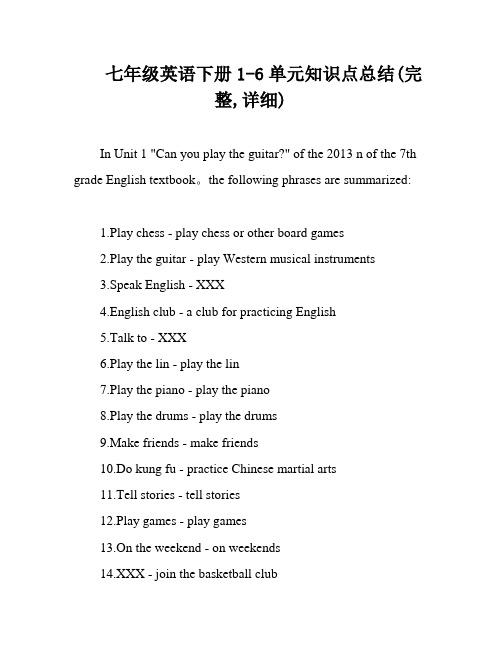
七年级英语下册1-6单元知识点总结(完整,详细)In Unit 1 "Can you play the guitar?" of the 2013 n of the 7th grade English textbook。
the following phrases are summarized:1.Play chess - play chess or other board games2.Play the guitar - play Western musical instruments3.Speak English - XXX4.English club - a club for practicing English5.Talk to - XXX6.Play the lin - play the lin7.Play the piano - play the piano8.Play the drums - play the drums9.Make friends - make friends10.Do kung fu - practice Chinese martial arts11.Tell stories - tell stories12.Play games - play games13.On the weekend - on weekends14.XXX - join the basketball clubHere are some usage notes:1."Can do" can be replaced with "be able to do"e "play the" before the name of the instrumente "join" to participate in XXX4."Say" is used for the content of speech。
七年级下册1到6单元英语知识点

七年级下册1到6单元英语知识点
以下是七年级下册英语1到6单元的一些主要知识点:
1. Unit 1: Personal Information
-介绍自己的基本信息,如姓名、年龄、国籍等。
-问与回答关于个人信息的问题。
-学习使用形容词来描述自己和他人。
2. Unit 2: School Life
-学习和使用关于学校生活的词汇,如科目、课程表、校园设施等。
-学习描述日常活动和时间表。
-学习使用一般现在时来表达习惯和常规。
3. Unit 3: Hobbies and Interests
-学习和使用关于爱好和兴趣的词汇,如运动、音乐、艺术等。
-学习表达自己的喜好和不喜欢。
-学习使用动词的-ing形式来描述正在进行的活动。
4. Unit 4: Daily Routines
-学习和使用关于日常生活的词汇,如起床、吃早餐、上学等。
-学习描述日常活动的顺序和时间。
-学习使用一般现在时来描述日常例行事务。
5. Unit 5: Food and Health
-学习和使用关于食物和健康的词汇,如水果、蔬菜、饮食习惯等。
-学习表达食物的喜好和不喜欢。
-学习使用情态动词can和should来表达能力和建议。
6. Unit 6: Travel and Transportation
-学习和使用关于旅行和交通的词汇,如旅游景点、交通工具等。
-学习描述旅行计划和行程。
-学习使用一般将来时来表达将来的计划和打算。
《新目标英语》七年级下册 重点句型短语归纳
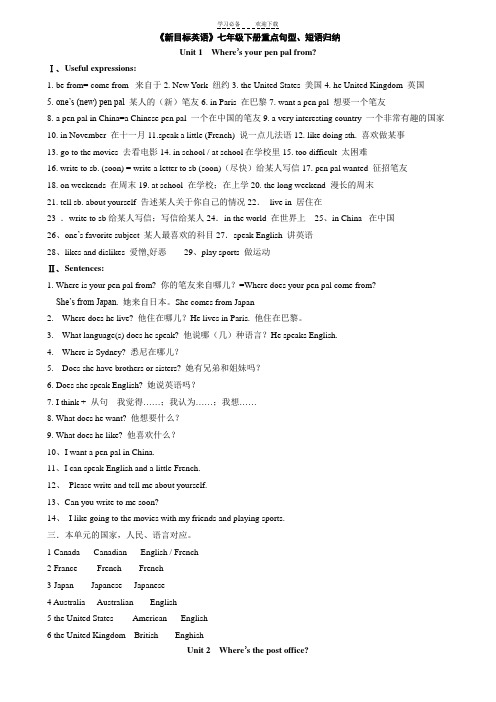
《新目标英语》七年级下册重点句型、短语归纳Unit 1 Where’s your pen pal from?Ⅰ、Useful expressions:1. be from= come from 来自于2. New York 纽约3. the United States 美国4. he United Kingdom 英国5. one’s (new) pen pal 某人的(新)笔友6. in Paris 在巴黎7. want a pen pal 想要一个笔友8. a pen pal in China=a Chinese pen pal 一个在中国的笔友9. a very interesting country 一个非常有趣的国家10. in November 在十一月11.speak a little (French) 说一点儿法语12. like doing sth. 喜欢做某事13. go to the movies 去看电影14. in school / at school在学校里15. too difficult 太困难16. write to sb. (soon) = write a letter to sb (soon)(尽快)给某人写信17. pen pal wanted 征招笔友18. on weekends 在周末19. at school 在学校;在上学20. the long weekend 漫长的周末21. tell sb. about yourself 告述某人关于你自己的情况22.live in 居住在---23 .write to sb给某人写信;写信给某人24.in the world 在世界上25、in China 在中国26、one’s favorite subject 某人最喜欢的科目27.speak English 讲英语28、likes and dislikes 爱憎,好恶29、play sports 做运动Ⅱ、Sentences:1. Where is your pen pal from? 你的笔友来自哪儿?=Where does your pen pal come from?She’s from Japan. 她来自日本。
新目标go,for,it,七年级下册单元单词及知识点

新目标go,for,it,七年级下册单元单词及知识点篇一:新版新目标英语七年级下册各单元知识点汇总新版新目标英语七年级下册各单元知识点汇总Unit 1 Can you play the guitar1. guitar为一种乐器,注意play与表示乐器的名词连用时,前要加定冠词the。
2. join意为―参加(某个组织成为其成员)‖,一般常和介词in连用。
3. have a swim游泳;go swimming去游泳4. ―下棋‖用play chess,而不用play the chess。
5. Painted 派生词:painter n.画家 painting n.画(注意与draw的区别: paint指用颜料等绘画;而draw指用钢笔、铅笔等画。
)6. 注意区分:speak,say,talk和tella) ①say指用语言表达思想,着重说话的内容或强调说话这一动作,不表示说话的性质。
b) ②speak强调说话的动作、声音,而不强调内容。
在正式场合表示发言、演讲,说某种语言用speak。
c) ③talk表示两个人或多个人在一起讲话、谈论(多指随意谈论)。
d)④tell的意思是―告诉,讲述,吩咐‖,讲故事或讲笑话多用tell。
7. 弹钢琴要用play the piano,其中定冠词the不能省略。
8. Show 用法:show作动词,意为―表演,演出,出示……给某人看‖,有时与介词搭配使用,构成show sth. to sb.=show sb. sth.。
show作名词,意为―展览,展出‖。
构成短语on show,意为―在展出‖。
9. 表示―在星期几‖要用介词on。
如:on Sunday―在星期日‖。
10. Little 用法:1)little还有―小的,小巧的‖之意,带有小的可爱之意。
2)注意little与a little 的区别:little与a little都可表示数量,修饰不可数名词。
但little表示否定意义,而a little表示肯定意义。
七年级下学期英语各章节重要内容归纳

七年级下学期英语各章节重要内容归纳第一章:学校生活- 学科和教室- 学校设施和设备- 学校规则和制度- 课程时间表和课堂活动第二章:我的家庭- 家庭成员和亲戚关系- 家庭成员的职业和兴趣爱好- 家庭规则和家庭活动- 家庭成员之间的相处方式第三章:我的城市- 城市名称和地理位置- 城市景点和旅游景点- 城市交通和交通方式- 城市的文化和传统第四章:我的课余活动- 研究和爱好- 校外活动和俱乐部- 社交媒体和娱乐活动- 个人兴趣和追求第五章:购物和服装- 商店和市场- 购物的常用英语表达- 服装和时尚趋势- 参观商店和挑选服装第六章:健康和运动- 健康惯和饮食- 锻炼和运动方式- 平衡研究和休息- 保持健康的重要性第七章:节日和庆祝活动- 重要节日和传统俗- 节日庆祝活动和食物- 节日的意义和重要性- 节日庆祝的方式和惯第八章:环境保护- 环境问题和污染- 环境保护的重要性- 减少污染的方法和措施- 环境友好的生活方式第九章:世界各地的人们- 不同国家和地区的人们- 语言和文化差异- 人们的生活方式和传统- 尊重和理解不同文化背景的重要性第十章:未来的计划和梦想- 个人目标和职业梦想- 未来计划和学业规划- 实现梦想的方法和步骤- 努力和坚持的重要性以上是七年级下学期英语各章节的重要内容归纳。
每个章节都涉及不同主题,帮助学生了解和掌握相关的词汇和表达。
学生可以通过学习这些内容来提高英语水平和跨文化交流能力。
新目标人教版英语七年级上下册重点语法总结
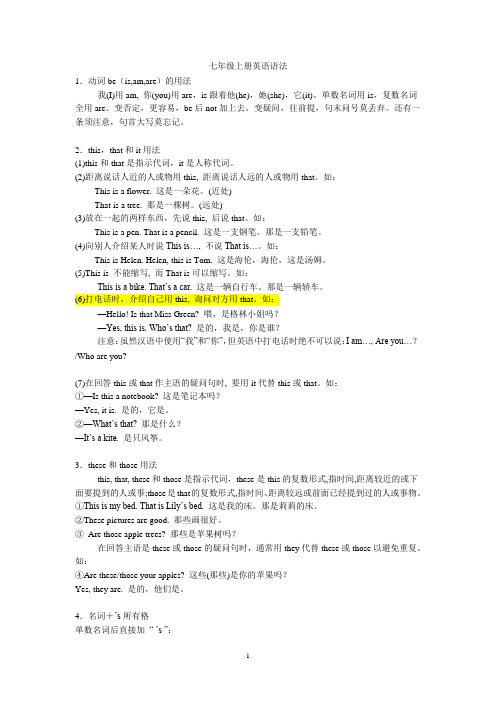
七年级上册英语语法1.动词be(is,am,are)的用法我(I)用am, 你(you)用are,is跟着他(he),她(she),它(it)。
单数名词用is,复数名词全用are。
变否定,更容易,be后not加上去。
变疑问,往前提,句末问号莫丢弃。
还有一条须注意,句首大写莫忘记。
2.this,that和it用法(1)this和that是指示代词,it是人称代词。
(2)距离说话人近的人或物用this, 距离说话人远的人或物用that。
如:This is a flower. 这是一朵花。
(近处)That is a tree. 那是一棵树。
(远处)(3)放在一起的两样东西,先说this, 后说that。
如:This is a pen. That is a pencil. 这是一支钢笔。
那是一支铅笔。
(4)向别人介绍某人时说This is…, 不说That is…。
如:This is Helen. Helen, this is Tom. 这是海伦,海伦,这是汤姆。
(5)This is 不能缩写, 而That is可以缩写。
如:This is a bike. That’s a car. 这是一辆自行车。
那是一辆轿车。
(6)打电话时,介绍自己用this, 询问对方用that。
如:—Hello! Is that Miss Green? 喂,是格林小姐吗?—Yes, this is. Who’s that? 是的,我是,你是谁?注意:虽然汉语中使用“我”和“你”,但英语中打电话时绝不可以说:I am…, Are you…?/Who are you?(7)在回答this或that作主语的疑问句时, 要用it代替this或that。
如:①—Is this a notebook? 这是笔记本吗?—Yes, it is. 是的,它是。
②—What’s that? 那是什么?—It’s a kite. 是只风筝。
3.these和those用法this, that, these和those是指示代词,these是this的复数形式,指时间,距离较近的或下面要提到的人或事;those是that的复数形式,指时间、距离较远或前面已经提到过的人或事物。
最新新目标英语七年级下册1—6单元重要语法知识
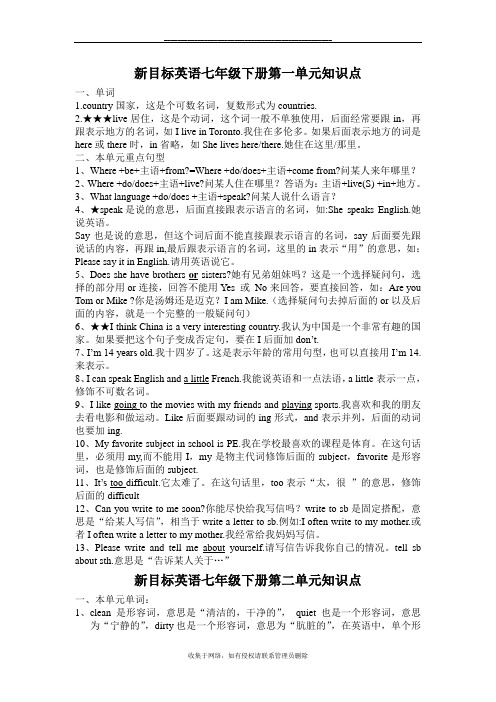
新目标英语七年级下册第一单元知识点一、单词1.country国家,这是个可数名词,复数形式为countries.2.★★★live居住,这是个动词,这个词一般不单独使用,后面经常要跟in,再跟表示地方的名词,如I live in Toronto.我住在多伦多。
如果后面表示地方的词是here或there时,in省略,如She lives here/there.她住在这里/那里。
二、本单元重点句型1、Where +be+主语+from?=Where +do/does+主语+come from?问某人来年哪里?2、Where +do/does+主语+live?问某人住在哪里?答语为:主语+live(S) +in+地方。
3、What language +do/does +主语+speak?问某人说什么语言?4、★speak是说的意思,后面直接跟表示语言的名词,如:She speaks English.她说英语。
Say也是说的意思,但这个词后面不能直接跟表示语言的名词,say后面要先跟说话的内容,再跟in,最后跟表示语言的名词,这里的in表示“用”的意思,如:Please say it in English.请用英语说它。
5、Does she have brothers or sisters?她有兄弟姐妹吗?这是一个选择疑问句,选择的部分用or连接,回答不能用Yes 或No来回答,要直接回答,如:Are you Tom or Mike ?你是汤姆还是迈克?I am Mike.(选择疑问句去掉后面的or以及后面的内容,就是一个完整的一般疑问句)6、★★I think China is a very interesting country.我认为中国是一个非常有趣的国家。
如果要把这个句子变成否定句,要在I后面加don’t.7、I’m 14 years old.我十四岁了。
这是表示年龄的常用句型,也可以直接用I’m 14.来表示。
七年级下册英语1-6单元知识点

七年级下册英语1-6单元知识点1. 单元一:Unit 1 School Life- 学习怎样询问和回答学校生活相关的问题:如何询问和回答名字、年级、国籍、学科和爱好等。
- 学习如何咨询和就餐的相关问题:如何询问并点餐。
- 学习如何询问和回答时间以及日常活动:如何询问和表达上学放学时间,及日常活动安排等。
- 学习如何询问和回答关于学习和家庭作业等相关问题:如何询问和回答关于考试、作业等相关问题。
2. 单元二:Unit 2 Seasons and Weather- 学习天气和季节的表达:"What's the weather like today?" "It's sunny/cloudy/rainy/windy/snowy." "What's your favorite season?" - 学习日常穿着和衣物的表达:如何询问和回答关于自己所穿衣物的颜色、种类和材质等。
- 学习月份和节日的表达:如何询问和回答生日、节日及其庆祝方式。
- 学习关于季节和天气的句型:如how's the weather? What season is it?等。
3. 单元三:Unit 3 Hobbies- 学习如何谈论自己的爱好:如户外活动、音乐、艺术、运动等。
- 学习如何向他人询问并回答关于爱好的问题:如"What's your hobby?" "I like playing basketball."- 学习如何谈论自己的兴趣和喜欢的事物:如音乐、电影等。
4. 单元四:Unit 4 Food and Drinks- 学习食物和饮品的表达:如汉堡、面条、鸡蛋、饺子、饼干、果汁、牛奶等。
- 学习如何点餐和询问关于食物的问题:如"I'd like a hamburger, please." "What would you like for breakfast?"- 学习如何询问和回答关于饮食习惯和健康的问题:如"You should eat more fruits and vegetables." "I like eating junk food."5. 单元五:Unit 5 Clothes and Shopping- 学习衣物和购物的表达:如衬衫、裤子、裙子、鞋子、帽子等。
七年级下册英语1~6单元知识点
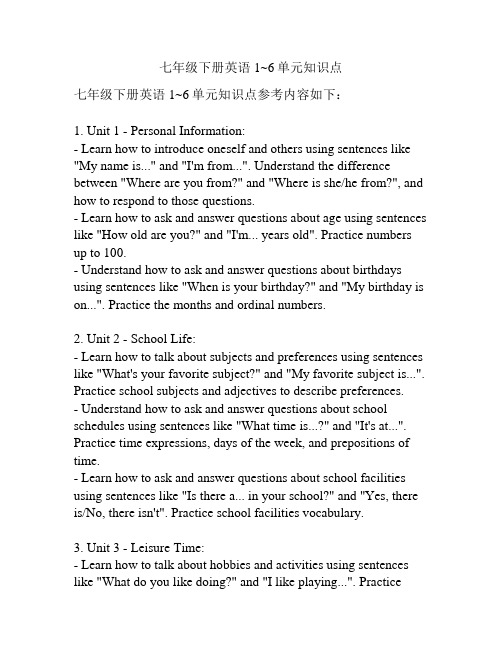
七年级下册英语1~6单元知识点七年级下册英语1~6单元知识点参考内容如下:1. Unit 1 - Personal Information:- Learn how to introduce oneself and others using sentences like "My name is..." and "I'm from...". Understand the difference between "Where are you from?" and "Where is she/he from?", and how to respond to those questions.- Learn how to ask and answer questions about age using sentences like "How old are you?" and "I'm... years old". Practice numbers up to 100.- Understand how to ask and answer questions about birthdays using sentences like "When is your birthday?" and "My birthday is on...". Practice the months and ordinal numbers.2. Unit 2 - School Life:- Learn how to talk about subjects and preferences using sentences like "What's your favorite subject?" and "My favorite subject is...". Practice school subjects and adjectives to describe preferences.- Understand how to ask and answer questions about school schedules using sentences like "What time is...?" and "It's at...". Practice time expressions, days of the week, and prepositions of time.- Learn how to ask and answer questions about school facilities using sentences like "Is there a... in your school?" and "Yes, there is/No, there isn't". Practice school facilities vocabulary.3. Unit 3 - Leisure Time:- Learn how to talk about hobbies and activities using sentences like "What do you like doing?" and "I like playing...". Practicehobbies vocabulary and verb patterns.- Understand how to ask and answer questions about frequency using sentences like "How often do you...?" and "I... every...". Practice adverbs of frequency.- Learn how to ask and answer questions about free time activities using sentences like "What does... like doing in his/her free time?" and "He/She likes...". Practice third-person singular pronouns and free time activities vocabulary.4. Unit 4 - Food and Drink:- Learn how to talk about meals, preferences, and dietary restrictions using sentences like "What do you have for...?" and "I don't eat...". Practice meals vocabulary, food and drinks vocabulary, and expressions of preferences.- Understand how to ask for and give recommendations using sentences like "What do you suggest?" and "I suggest...". Practice food and drink vocabulary related to recommendations.- Learn how to ask and answer questions about prices using sentences like "How much is...?" and "It's...". Practice numbers up to 1000 and currency vocabulary.5. Unit 5 - Careers:- Learn how to talk about jobs and aspirations using sentences like "What do you want to be?" and "I want to be a...". Practice jobs vocabulary and the future tense.- Understand how to ask and answer questions about job responsibilities using sentences like "What does a... do?" and "A... does...". Practice job descriptions vocabulary.- Learn how to ask and answer questions about work hours using sentences like "What time does... start/finish?" and "Itstarts/finishes at...". Practice time expressions related to work.6. Unit 6 - Around the World:- Learn how to talk about countries, nationalities, and languages using sentences like "What nationality are you?" and "I'm...". Practice countries, nationalities, and languages vocabulary.- Understand how to ask and answer questions about cities and attractions using sentences like "Is... a big city?" and "Yes, it is/No, it isn't". Practice city descriptions vocabulary and comparative adjectives.- Learn how to ask for and give directions using sentences like "How do I get to...?" and "Go straight...". Practice directional vocabulary and prepositions of place.Remember, this is just a reference. It's important to study the specific textbook and exercises provided by your school or teacher to fully grasp all the knowledge points covered in each unit.。
- 1、下载文档前请自行甄别文档内容的完整性,平台不提供额外的编辑、内容补充、找答案等附加服务。
- 2、"仅部分预览"的文档,不可在线预览部分如存在完整性等问题,可反馈申请退款(可完整预览的文档不适用该条件!)。
- 3、如文档侵犯您的权益,请联系客服反馈,我们会尽快为您处理(人工客服工作时间:9:00-18:30)。
新目标英语七年级下册第一单元知识点一、单词1.country国家,这是个可数名词,复数形式为countries.2.★★★live居住,这是个动词,这个词一般不单独使用,后面经常要跟in,再跟表示地方的名词,如I live in Toronto.我住在多伦多。
如果后面表示地方的词是here或there时,in省略,如She lives here/there.她住在这里/那里。
二、本单元重点句型1、Where +be+主语+from?=Where +do/does+主语+come from?问某人来年哪里?2、Where +do/does+主语+live?问某人住在哪里?答语为:主语+live(S) +in+地方。
3、What language +do/does +主语+speak?问某人说什么语言?4、★speak是说的意思,后面直接跟表示语言的名词,如:She speaks English.她说英语。
Say也是说的意思,但这个词后面不能直接跟表示语言的名词,say后面要先跟说话的内容,再跟in,最后跟表示语言的名词,这里的in表示“用”的意思,如:Please say it in English.请用英语说它。
5、Does she have brothers or sisters?她有兄弟姐妹吗?这是一个选择疑问句,选择的部分用or连接,回答不能用Yes 或No来回答,要直接回答,如:Are you Tom or Mike ?你是汤姆还是迈克?I am Mike.(选择疑问句去掉后面的or以及后面的内容,就是一个完整的一般疑问句)6、★★I think China is a very interesting country.我认为中国是一个非常有趣的国家。
如果要把这个句子变成否定句,要在I后面加don’t.7、I’m 14 years old.我十四岁了。
这是表示年龄的常用句型,也可以直接用I’m 14.来表示。
8、I can speak English and a little French.我能说英语和一点法语,a little表示一点,修饰不可数名词。
9、I like going to the movies with my friends and playing sports.我喜欢和我的朋友去看电影和做运动。
Like后面要跟动词的ing形式,and表示并列,后面的动词也要加ing.10、My favorite subject in school is PE.我在学校最喜欢的课程是体育。
在这句话里,必须用my,而不能用I,my是物主代词修饰后面的subject,favorite是形容词,也是修饰后面的subject.11、It’s too difficult.它太难了。
在这句话里,too表示“太,很”的意思,修饰后面的difficult12、Can you write to me soon?你能尽快给我写信吗?write to sb是固定搭配,意思是“给某人写信”,相当于write a letter to sb.例如:I often write to my mother.或者I often write a letter to my mother.我经常给我妈妈写信。
13、Please write and tell me about yourself.请写信告诉我你自己的情况。
tell sb about sth.意思是“告诉某人关于…”新目标英语七年级下册第二单元知识点一、本单元单词:1、clean 是形容词,意思是“清洁的,干净的”,quiet 也是一个形容词,意思为“宁静的”,dirty也是一个形容词,意思为“肮脏的”,在英语中,单个形容词修饰名词时,一般放在被修饰词的前面。
如:a clean street一条干净的街道,a quiet park一个宁净的公园,a dirty park一个肮脏的公园。
2、on the right在右边,如果要表示“在你的右边”,on your right,在这两个句型中,一定要用介词on.★★3、enjoy,是个动词,意思是“享受…的乐趣;欣赏”,它是个重点词,一定要记住,它一般构成两个常用结构:①enjoy doing sth“喜欢做某事”,例如:I enjoy watching TV.我喜欢看电视。
②enjoy oneself表示“玩得高兴,过得愉快”,例如:I enjoy myself in the park.我在公园里玩得很开心。
★4、have fun这个词组的意思是“玩的开心”的意思,例如:I have fun in the park. 我在公园里玩得很开心。
【重点】在英语中,表示“玩的开心,过得愉快”常用的结构有三个,分别是enjoy oneself=have fun=have a good/great time例如:I have a good time in the park.我在公园里玩得很开心。
5、arrive,这是个动词,表示“到达,抵达”的意思,一般不单独使用,后面要跟介词in或at,再跟表示地方的名词,如果到达的地方是个大地方,如国家,城市等,要用in ,如果到达的地方是个小地方,如村庄,车站等,要用at ,例如:I arrived in Beijing yesterday.我昨天到达的北京。
I will arrive at the bus station in half an hour.半小时后我会到达汽车站。
【注意】如果arrive后要跟here/there,千万不能用in/at,例如:I will arrive there in half an hour. 我半小时会到达那里。
6、through与across的区别:through穿过,从……中通过;着重指从空间的一头纵穿到另一头,含义与in有关。
例如:The thief got in through the window.小偷是通过这扇窗户进来的。
Across横过,穿过;着重指从一条线或一物体的一边到另一边,含义与on有关。
例如:Let’s go across the street.咱们穿过这条街吧。
二、本单元常用结构:1、位置关系的表达:A is across from B. A在B的对面。
【两个物体位置比较】A is next to B. A紧挨着B。
【两个物体位置比较】A is in front of B. A在B的前面。
【两个物体位置比较】A is behind B. A 在B的后面。
【两个物体位置比较】A is on Green Street . A在格林大街上。
A is betweenB and C. A在B和C之间。
【三个物体位置比较】2、★★★there is/are表示“有”的意思,常用结构是“There is/are +主语+地点”,表示“某地有某物”,BE动词应与后面的主语保持一致。
它的考点是“就近原则”,如果BE后面的主语由and连接,动词be的形式取决于后面紧跟的名词的单复数形式。
如:There is a pen and two books on the desk.There are two books and a pen on the desk.2、问路的表达:Excuse me, where is…?打扰一下,…在哪?Excuse me, how can I get t o…? 打扰一下,我怎么去…Excuse me, could you tell me the way t o…? 打扰一下,你能告诉我去…的路吗?3、Across from the park is an old hotel.这是一个倒装句,正常的语序是“Anold hotel is across from the park.”在公园的对面是一家旧旅馆。
4、★★★Next to the hotel is a small house with an interesting garden.在这个句子里,with是“带有”的意思。
5、This is the beginning of garden tour.在这个句子里he beginning of是…的开始,开端。
6、★★★Bridge street is a good place to have fun.布里奇街是一个可以玩得很开心的好地方。
to have fun是短语,用来修饰前面的place7、I know you are arriving next Sunday.这是一个现在进行时的句子,不表示正在进行,而是表示按计划要做,还未进行。
8、Let me tell you the way to my house.在这个句子中the way to意思是“去…的路”。
9、I hope you have a good trip.旅途愉快。
10、Go down Center Street.沿着中央大街走。
11、★★★yours名词性物主代词。
相当于your+名词。
例如:A:This is mypen.B:That is yours.(在这句答语里,yours=your pen)新目标英语七年级下册第三单元知识点一、本单元单词:1、grass草,不可数。
2、meat肉,不可数。
3、leaf枝叶,复数形式是leaves.二、本单元常用结构:1、★★Let’s see the pandas first.咱们先去看熊猫吧。
【注意】这是一个常考句型。
let sb do sth让某人做某事,或建议某人做某事。
千万注意,不论let后面跟哪个人称代词或名词,这个表人称的词后面一定要跟一个动词原形。
另外,在这个句子里,first不是第一,而是首先的意思,此外的first前不用加the.2、why问because答。
3、I like elephants.对此名进行画线提问,应该是What animals do you like?4、She likes to play with her friends .在这个句子里,play with“与…一起玩”,或“玩弄”。
5、★★★Please be very quiet.在这个句子里,只能用be,不能用其它be动词。
6、Isn’t he cute?这是一个否定疑问句。
去掉not就是一般疑问句。
【注意】否定疑问句的答语是考试重点。
回答否定疑问句时,与汉语习惯不同,肯定回答用yes,否定用no,但翻译时,意思相反。
如:Isn’t it an interesting book?难道这不是一本有趣的书吗?Yes, it is. 不,它是。
No, it isn’t .是的,它不是。
